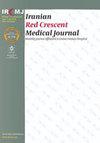Evaluation of Lower Urinary Symptoms Following Vaginal Reconstructive Surgery for Prolapse and Urinary Incontinence
IF 0.4
4区 医学
引用次数: 0
Abstract
Background: Urinary incontinence (UI) may be associated with symptoms of overactive bladder (OAB) that may persist after anti-incontinence surgery. Objectives: The present study was performed to evaluate the effect of prolapse and anti-incontinence reconstructive surgery in women who had the symptoms of OAB and UI at the same time. Methods: This descriptive cross-sectional study was performed on 56 women with OAB symptoms and stress UI (SUI)/urgency UI (UUI) with or without prolapse who were candidates for restorative and anti-incontinence surgery. At baseline, urinary symptoms, including urinary frequency, nocturia, SUI, and UUI, were recorded. Patients who finally underwent vaginal reconstructive surgery with anti-incontinence surgery were assessed for urinary symptoms six months after the operation. Results: A total of 28 patients underwent transobturator tape (TOT) surgery, of whom 23 patients were subjected to other anti-incontinence surgeries and 5 patients underwent restorative surgeries. There was no significant difference between the two groups (TOT and others) in terms of age, body mass index, number of deliveries, history of medical problems, and history of surgery or cesarean section. The urinary frequency and nocturia before surgery were observed in 46 (82%) and 20 (36%) patients, respectively, which were not significantly different between the two groups. Before the study, occult UI was observed in 2 patients (4%), UUI in 3 patients (5%), SUI in 18 patients (32%), and mixed UI in 33 patients (59%). Nocturia was completely improved in all 20 patients. Urinary frequency was partially or completely improved in 41 patients (89%), which was not significantly different between the two groups (P=0.051). Overall, 53 patients (95%) had partial or complete improvement in UI, which was not significantly different between the two groups (P=0.058). Both patients with occult UI and all three patients with UUI were completely improved. Sixteen out of 18 patients (89%) with SUI were completely improved and the other 2 patients were partially improved. Thirty patients (91%) with mixed UI had a complete or partial recovery that was not significantly different between the two groups (P=0.137). Conclusion: The findings of the present study showed that six months after anti-incontinence or reconstructive surgery, nocturia in all patients and urinary frequency in 89% of patients improved partially or completely. Various forms of UI partially or completely improved in 95% of patients, as well.针对脱垂和尿失禁的阴道重建手术后的下尿路症状评估
背景:尿失禁(UI)可能与膀胱过度活动症(OAB)症状有关,而这些症状在抗尿失禁手术后可能会持续存在。研究目的本研究旨在评估同时伴有膀胱过度活动症和尿失禁症状的女性接受脱垂和抗尿失禁重建手术的效果。方法:这是一项描述性横断面研究:这项描述性横断面研究的对象是 56 名有 OAB 症状和压力性尿失禁(SUI)/急迫性尿失禁(UUI)并伴有或不伴有脱垂的女性,她们都是修复和抗尿失禁手术的候选者。在基线阶段,患者的排尿症状(包括尿频、夜尿、尿急和尿失禁)均被记录在案。最终接受阴道重建手术和抗尿失禁手术的患者在术后六个月接受排尿症状评估。结果共有 28 名患者接受了经尿道胶带(TOT)手术,其中 23 名患者接受了其他防尿失禁手术,5 名患者接受了修复手术。两组患者(TOT 和其他)在年龄、体重指数、分娩次数、病史、手术史或剖腹产史方面没有明显差异。术前观察到尿频和夜尿的患者分别有 46 人(82%)和 20 人(36%),两组之间无明显差异。研究前,2 名患者(4%)观察到隐匿性尿频,3 名患者(5%)观察到尿急,18 名患者(32%)观察到 SUI,33 名患者(59%)观察到混合性尿频。所有 20 名患者的夜尿症都得到了完全改善。41 名患者(89%)的尿频得到部分或完全改善,两组之间无明显差异(P=0.051)。总体而言,53 名患者(95%)的尿频症状得到部分或完全改善,两组之间无明显差异(P=0.058)。两组隐性尿失禁患者和三组尿失禁患者均完全好转。18 名 SUI 患者中有 16 人(89%)完全好转,另外 2 人部分好转。30名混合型尿失禁患者(91%)完全或部分痊愈,两组之间无明显差异(P=0.137)。结论本研究结果表明,在抗尿失禁或重建手术后六个月,所有患者的夜尿症和 89% 患者的尿频得到了部分或完全的改善。95%的患者的各种尿失禁症状也得到了部分或完全改善。
本文章由计算机程序翻译,如有差异,请以英文原文为准。
求助全文
约1分钟内获得全文
求助全文
来源期刊

Iranian Red Crescent Medical Journal
医学-医学:内科
自引率
0.00%
发文量
0
期刊介绍:
The IRANIAN RED CRESCENT MEDICAL JOURNAL is an international, English language, peer-reviewed journal dealing with general Medicine and Surgery, Disaster Medicine and Health Policy. It is an official Journal of the Iranian Hospital Dubai and is published monthly. The Iranian Red Crescent Medical Journal aims at publishing the high quality materials, both clinical and scientific, on all aspects of Medicine and Surgery
 求助内容:
求助内容: 应助结果提醒方式:
应助结果提醒方式:


